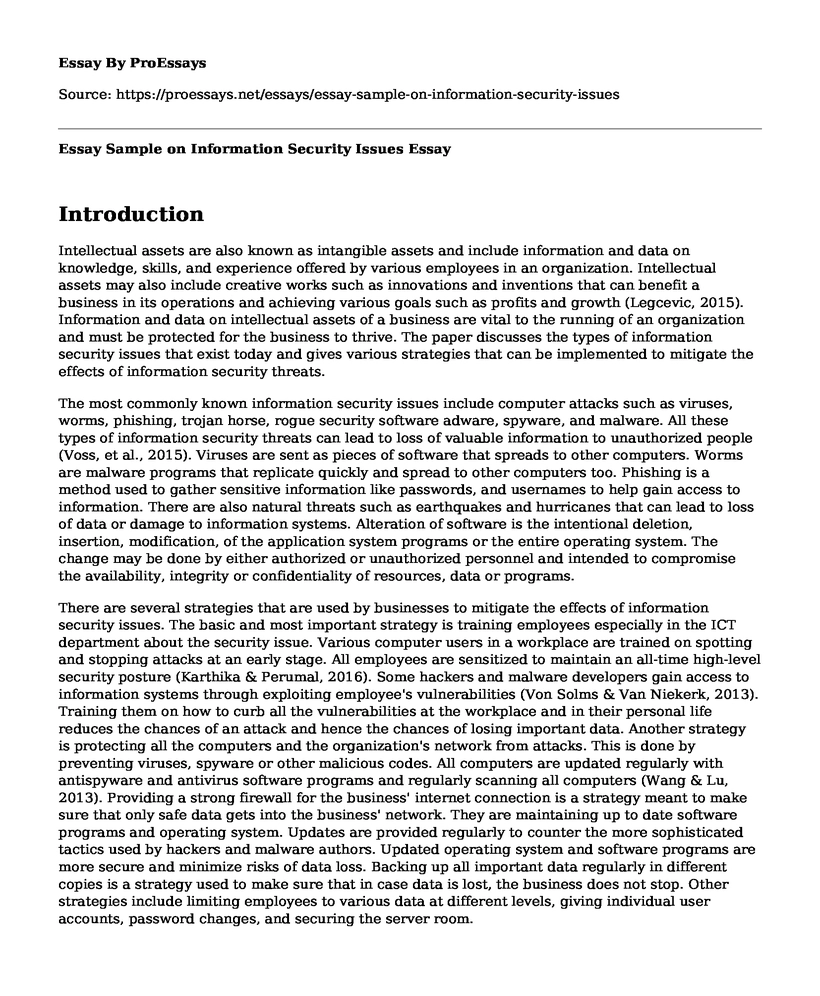Introduction
Intellectual assets are also known as intangible assets and include information and data on knowledge, skills, and experience offered by various employees in an organization. Intellectual assets may also include creative works such as innovations and inventions that can benefit a business in its operations and achieving various goals such as profits and growth (Legcevic, 2015). Information and data on intellectual assets of a business are vital to the running of an organization and must be protected for the business to thrive. The paper discusses the types of information security issues that exist today and gives various strategies that can be implemented to mitigate the effects of information security threats.
The most commonly known information security issues include computer attacks such as viruses, worms, phishing, trojan horse, rogue security software adware, spyware, and malware. All these types of information security threats can lead to loss of valuable information to unauthorized people (Voss, et al., 2015). Viruses are sent as pieces of software that spreads to other computers. Worms are malware programs that replicate quickly and spread to other computers too. Phishing is a method used to gather sensitive information like passwords, and usernames to help gain access to information. There are also natural threats such as earthquakes and hurricanes that can lead to loss of data or damage to information systems. Alteration of software is the intentional deletion, insertion, modification, of the application system programs or the entire operating system. The change may be done by either authorized or unauthorized personnel and intended to compromise the availability, integrity or confidentiality of resources, data or programs.
There are several strategies that are used by businesses to mitigate the effects of information security issues. The basic and most important strategy is training employees especially in the ICT department about the security issue. Various computer users in a workplace are trained on spotting and stopping attacks at an early stage. All employees are sensitized to maintain an all-time high-level security posture (Karthika & Perumal, 2016). Some hackers and malware developers gain access to information systems through exploiting employee's vulnerabilities (Von Solms & Van Niekerk, 2013). Training them on how to curb all the vulnerabilities at the workplace and in their personal life reduces the chances of an attack and hence the chances of losing important data. Another strategy is protecting all the computers and the organization's network from attacks. This is done by preventing viruses, spyware or other malicious codes. All computers are updated regularly with antispyware and antivirus software programs and regularly scanning all computers (Wang & Lu, 2013). Providing a strong firewall for the business' internet connection is a strategy meant to make sure that only safe data gets into the business' network. They are maintaining up to date software programs and operating system. Updates are provided regularly to counter the more sophisticated tactics used by hackers and malware authors. Updated operating system and software programs are more secure and minimize risks of data loss. Backing up all important data regularly in different copies is a strategy used to make sure that in case data is lost, the business does not stop. Other strategies include limiting employees to various data at different levels, giving individual user accounts, password changes, and securing the server room.
Intellectual assets and information are vital components while running any business, and thus must be secured under any cost. Some of the information security threats include viruses, worms, phishing, trojan horse, rogue security software adware, spyware, and malware. These threats are used by malicious people to get access to information or business data. Businesses, on the other hand, use various strategies to counter these vulnerabilities. Strategies used include employee training, use of updated antiviruses and antispyware software, firewalls, and regularly updating the software applications and the operating system.
References
Karthika, L., & Perumal, V. (2016). A study on phishing attack in internet banking. International journal of Interdisciplinary in Engineering Science and Technology, 1(2), 29-32.
Legcevic, J. (2015). Intelectual Capital As A Driving Force Of Economic Development. Interdisciplinary Management Research, 11, 112-120.
Von Solms, R., & Van Niekerk, J. (2013). From information security to cyber security. computers & security, 38, 97-102.
Voss, W. G., Woodcock, K. H., Chung, C. S., & Kim, K. Y. (2015). Privacy, E-Commerce, and Data Security. The International Lawyer, 49, 97.
Wang, W., & Lu, Z. (2013). Cyber security in the smart grid: Survey and challenges. Computer Networks, 57(5), 1344-1371.
Cite this page
Essay Sample on Information Security Issues. (2022, Nov 20). Retrieved from https://proessays.net/essays/essay-sample-on-information-security-issues
If you are the original author of this essay and no longer wish to have it published on the ProEssays website, please click below to request its removal:
- Mother's Choice Bakers New Branch Essay
- Production Method and the Best Technique for Manufacture Essay
- Shashi Jewelry: Strengths Include Teamwork & Location - Research Paper
- Leadership & Ethics: The Ethical Lens Inventory - Essay Sample
- Management vs. Leadership: What's the Difference? - Essay Sample
- Essay Sample on Co-Opetition: Achieving Mutual Benefit Through Supply Networks
- Leadership Styles of Sheikh Zayed & Sir Richard Branson - Essay Sample







